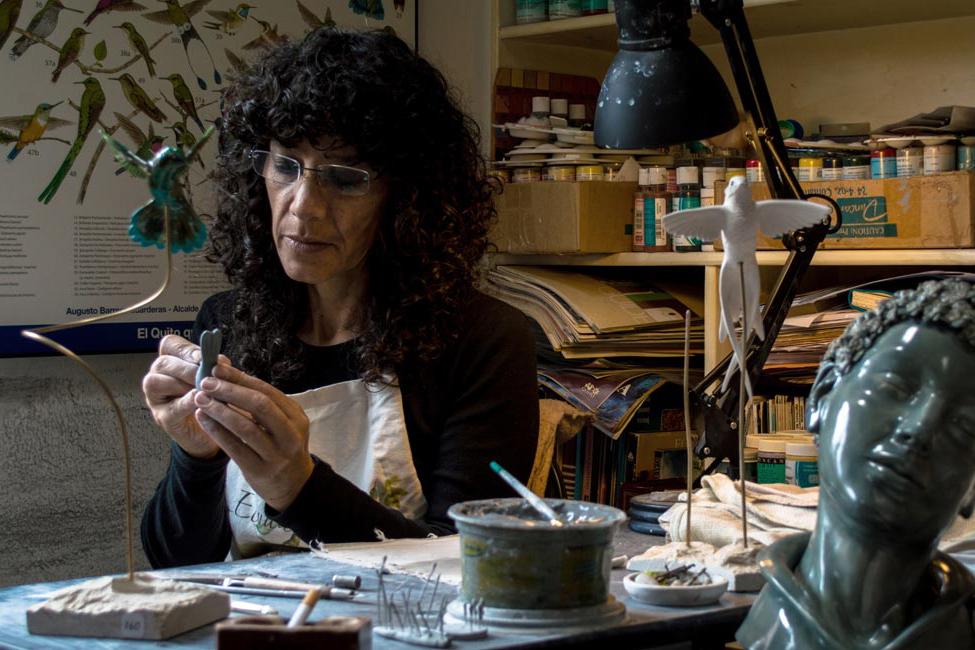Description
Arte empleado principalmente para crear imágenes religiosas. La talla en madera adquiere gran importancia en Ecuador durante la época de la Colonia (s. XVI-XIX), cuando se establecieron las primeras escuelas de artes y oficios que dieron lugar a nuevas manifestaciones culturales y artísticas, producto del sincretismo acaecido.
Inmersa en este escenario, la actual provincia de Imbabura mantuvo una cercana relación con este quehacer desarrollado inicialmente en Quito, donde el escultor Daniel Reyes, oriundo de San Antonio de Ibarra, aprendió el arte a temprana edad, para después dominarlo gracias al contacto con artistas restauradores de la Escuela Quiteña. En 1884 fundó el Liceo de Artes y Oficios, espacio que formó a los primeros artesanos de la parroquia y cuyas generaciones posteriores, herederas de esta técnica, aportan a diario al desarrollo socioeconómico y cultural de la zona mediante la producción de muebles, escultura costumbrista, moderna y religiosa.
Gran diversidad de métodos como el tallado, el desbastado, el lijado, el emporado y el estucado se aplican a maderas de variadas especies como cedro, laurel, copal, pino, nogal y naranjillo. Las herramientas indispensables que acompañan al oficio son las gubias, los formones, las segadoras, las sierras y las lijas. Para la decoración se utilizan técnicas conocidas como estofado, esgrafiado, chinesco*, tela encolada, encarne, policromado, así como el uso de ojos de vidrio, metales y piedras preciosas.
En 2020 el CIDAP reconoció a diferentes artesanos con el premio Medalla CIDAP y San Antonio fue declarado Pueblo Mágico por el Ministerio de Turismo del Ecuador, incluyendo a la talla en su Lista Representativa del Patrimonio Cultural Inmaterial. A la fecha, en esta localidad se desarrollan diferentes actividades que revitalizan esta tradición, como el Festival de Escultura en Motosierra y la Bienal Nacional de Escultura.
English
Sculpture of San Antonio de Ibarra
This art is mainly used to create religious images. Wood carving acquired great importance in Ecuador during the Colonial period (16th-19th centuries), when the first schools of arts and crafts were established, which gave rise to new cultural and artistic manifestations, as a result of the syncretism that took place.
Immersed in this scenario, the current province of Imbabura maintained a close relationship with this activity, initially developed in Quito, where the sculptor Daniel Reyes, a native of San Antonio de Ibarra, learned the art at an early age, and later mastered it thanks to his contact with artists and restorers of the Quito School. In 1884 he founded the Liceo de Artes y Oficios, a place that trained the first artisans of the parish and whose later generations, heirs of this technique, contribute daily to the socio-economic and cultural development of the area through the production of furniture, traditional, modern and religious sculpture.
A wide variety of methods such as carving, roughing, sanding, emporado and stuccoing are applied to wood of various species such as cedar, laurel, copal, pine, walnut and “naranjillo”. The indispensable tools that accompany the craft are gouges, chisels, chisels, saws, saws and sandpaper. For decoration, techniques known as estofado, esgrafiado, chinesco*, tela encolada, encarne, polychrome, as well as the use of glass eyes, metals and precious stones are used.
In 2020, CIDAP recognised different artisans with the CIDAP Medal Award and San Antonio was declared a Magical Town by the Ministry of Tourism of Ecuador, including carving in its Representative List of Intangible Cultural Heritage. To date, different activities are carried out in this town that revitalise this tradition, such as the Festival de Escultura en Motosierra and the Bienal Nacional de Escultura.



Reviews
There are no reviews yet.